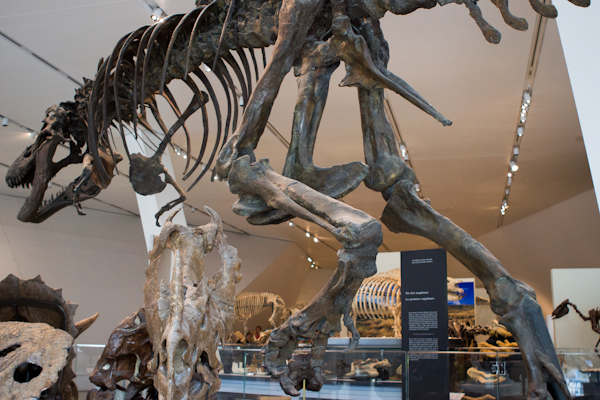T. rex vs. Pan Am Athletes: Who Would Win a Race?

Guest blog post by Environmental Visual Communication Student Lisa Milavic
With the revival of the Jurassic Park franchise this summer, the popular question gets raised again: can we clone dinosaurs? Although it is still a resounding “no” by scientists, we are still welcome to consider how cool it would be to visit a dinosaur park. And if we can learn one thing from Hollywood, it's that a locked up dinosaur will get out! Imagine that you were there if this happened. Do you think you could out-run a Tyrannosaurus rex? To answer this, we are going to look at the structure and biomechanics of the T. rex. Then for the sake of imagining a world where we could clone dinosaurs, we are going to guess how a T. rex would rank up against the athletes at the Toronto Pan Am Games.

Scientists face a lot of difficult guesswork when trying to extract behaviour from fragmented fossils, and it takes a multi-faceted approach. Recent research on biomechanics reveals that T. rex moved slower than previously thought, and was more likely equipped for speed-walking than running. Looking at the fossil record and comparing the smallest and largest specimens shows that, just like in humans, a T. rex's proportions changed as it grew older. The head and torso grew so fast from its teenage years, that it was like the equivalent of putting on 5 kg (11 lbs) of weight each day! It quickly became very front-heavy, shifting its centre of gravity forward. To balance its weight out, the legs required more strength. As a result, the limbs became bulkier and shorter – similar to large mammals alive today, like elephants, hippos and rhinos.
Smaller theropods (bipedal, carnivorous dinosaurs) stood with bent legs. This made them speedy and ready to out-run their predators and/or prey - but it takes fifty percent more energy to stand with bent legs than with your legs straight and locked. Standing with legs locked upright is actually preferred for large animals, conserving significant amounts of energy that would otherwise be needed to bear its considerable body weight. But there is a trade-off – speed.
After studying biomechanics through computer simulations, scientists can better estimate the likely speed of a T. rex. Some research suggests that an average walking speed for a T. rex would have been 11-16 kilometres an hour (7-10 miles per hour). Running, a T. rex may have reached top speeds of 24-40 km/h (15-25 mph). At the high end of that spectrum, a T. rex could catch up to an average person, while an olympic sprinter might survive such a terrifying chase.
So, how would a T. rex do if put to the test at the Pan Am Games track and field event?
Here are a few Canadian runners competing at the games that would likely be able to outrun a T. rex:
- Andre De Grasse, the fastest sprinter from Markham, ON and only 20 years old
- Kimberly Hyacinthe, a Quebecois sprinter who won gold in the 2009 and 2013 Summer Universaide, ON
- Nathan Brannen, an Olympic silver medal middle distance runner from Cambridge, ON
- Cameron Levins, a long-distance runner from BC who won bronze in the 2014 Commonwealth Games
Other events that a T. rex would not do too well in: shot put, discus throw, and the javelin throw. It's safe to say that if cloning were possible, a T. rex would probably not bring home any Pan Am Games medals. If you are taking a break from the games, come see the dinosaurs at the Royal Ontario Museum and imagine for yourself how they would have moved!
